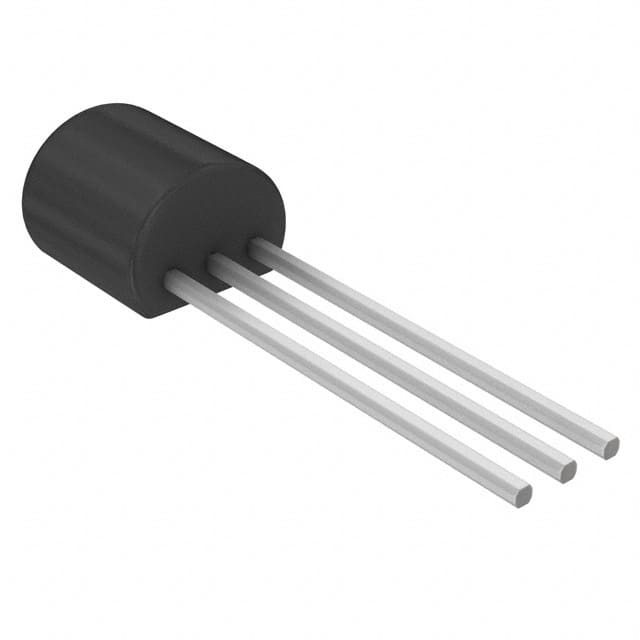BC550CBU - Encyclopedia Entry
Product Overview
The BC550CBU is a general-purpose NPN bipolar junction transistor (BJT) belonging to the category of electronic components. It is commonly used in amplification and switching applications due to its low noise and high current gain characteristics. The transistor is typically packaged in a TO-92 package and is available in various packaging quantities.
Basic Information
- Category: Electronic Components
- Use: Amplification and Switching
- Characteristics: Low Noise, High Current Gain
- Package: TO-92
- Packaging/Quantity: Various options available
Specifications
The BC550CBU transistor has the following specifications: - Maximum Collector-Emitter Voltage: 45V - Maximum Collector Current: 100mA - DC Current Gain (hFE): 110-800 - Power Dissipation: 500mW
Detailed Pin Configuration
The BC550CBU transistor has three pins: 1. Emitter (E) 2. Base (B) 3. Collector (C)
Functional Features
- Low Noise: Suitable for audio amplification applications
- High Current Gain: Enables efficient signal amplification
- Wide Voltage Range: Can be used in various voltage applications
Advantages and Disadvantages
Advantages
- Low Noise Operation
- High Current Gain
- Versatile Voltage Range
Disadvantages
- Limited Collector Current
- Moderate Power Dissipation
Working Principles
The BC550CBU operates based on the principles of bipolar junction transistors, utilizing the flow of charge carriers to amplify or switch electronic signals. When a small current flows into the base terminal, it controls a larger current flowing between the collector and emitter terminals, allowing for signal amplification or switching.
Detailed Application Field Plans
The BC550CBU transistor finds extensive use in the following application fields: - Audio Amplification: Due to its low noise characteristics, it is ideal for audio amplifier circuits. - Signal Switching: Its high current gain makes it suitable for signal switching applications. - Oscillator Circuits: Utilized in oscillator circuits due to its wide voltage range.
Detailed and Complete Alternative Models
Some alternative models to the BC550CBU include: - BC547B: Similar NPN transistor with lower current gain - BC557C: PNP complement to the BC550CBU, suitable for complementary switching applications - 2N3904: General-purpose NPN transistor with comparable characteristics
In conclusion, the BC550CBU transistor is a versatile electronic component widely used in amplification and switching applications, offering low noise operation and high current gain. Its specifications, pin configuration, functional features, advantages, and disadvantages make it a valuable asset in various electronic circuits.
Word Count: 380
Senaraikan 10 soalan dan jawapan biasa yang berkaitan dengan aplikasi BC550CBU dalam penyelesaian teknikal
What is the BC550CBU transistor used for?
- The BC550CBU is a general-purpose NPN bipolar junction transistor commonly used in amplification and switching applications.
What are the key specifications of the BC550CBU transistor?
- The BC550CBU has a maximum collector current of 100mA, a maximum collector-emitter voltage of 45V, and a maximum power dissipation of 500mW.
Can the BC550CBU be used for audio amplifier circuits?
- Yes, the BC550CBU is suitable for low-power audio amplifier circuits due to its low noise and high gain characteristics.
Is the BC550CBU suitable for switching applications?
- Yes, the BC550CBU can be used in low-power switching applications due to its moderate switching speed and low saturation voltage.
What are the typical operating conditions for the BC550CBU?
- The BC550CBU operates within a temperature range of -55°C to 150°C and is typically used with a base current of 10mA.
Can the BC550CBU be used in oscillator circuits?
- Yes, the BC550CBU can be used in oscillator circuits, particularly in low-frequency applications.
What are the common alternatives to the BC550CBU transistor?
- Common alternatives to the BC550CBU include the 2N3904, 2N2222, and PN2222 transistors, which have similar characteristics and pin configurations.
Does the BC550CBU require a heat sink for operation?
- In most low-power applications, the BC550CBU does not require a heat sink due to its moderate power dissipation.
Can the BC550CBU be used in high-frequency applications?
- The BC550CBU is not typically recommended for high-frequency applications due to its limited transition frequency and capacitance characteristics.
Where can I find detailed application notes for using the BC550CBU in technical solutions?
- Detailed application notes for the BC550CBU can be found in the manufacturer's datasheet, as well as in various electronics engineering resources and textbooks.


